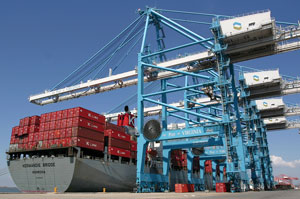
NOVEMBER 2006
All Pieces In Place (cover)
Mining Talent
HQs All Over
Research Heaven
Slaked Thirst
Request Information

VIRGINIA SPOTLIGHT
Mining Talent
A look inside the project numbers also reveals projects in Hampton Roads and the state's other corners that have a lot to say about the state's economic potential and staying power: Companies are not just moving goods,
 |
| According to the Virginia Port Authority, 36.1 million tons of cargo was handled by the state's ports in 2005, worth $44.9 million. |
After all, while most ports are expanding to handle container imports, Virginia's were honored in August by the U.S. Dept. of Commerce for their export achievements: From 2003- 2005, the Port of Virginia's container volume stood at 49 percent imports and 51 percent exports.
They don't all travel via the port, but the 35 mining trucks a year made by German firm Liebherr Mining Equipment Co.'s 34- year- old complex in Newport News need two flatbed trucks and six containers each to be shipped to their end users around the world.
K. Joachim Janka, president, Liebherr Mining Equipment Co., just moved to the company's Newport News, Va., facility in late 2005 after being stationed in Singapore and, before that, overseeing the construction of a greenfield plant in China. He says the Virginia facility began expanding last year and will continue to expand through building renovation, shop floor refurbishment and new machinery. Current employment stands at 420.
"The mining business is booming," he says, and the company aims to get its share. The plant makes the world's largest mining truck, the 360- metric- ton T282, at the rate of 35 a year. One truck at the end of the line is headed for a gold mine customer in the western U.S., and western Canada is a target region as well. The average truck has a useful life of 60,000 hours, or approximately 10 years, depending on site conditions.
Assembly began at the plant six years ago. Janka says the plan is to expand production each year by 10 percent, and also to add three more types of trucks, as the complex continues to grow over the next five to 10 years. One renovation was just completed at a cost of $3 million. Another $3.5- million investment in Colgar CNC equipment also just occurred, and the next investment will be in making the shop floor ready to facilitate assembly of more steel structures. Janka points to the 10- ft.- deep foundation under the new CNC equipment, which the company installed to maintaining stability in the relatively soft ground near the bay.
That assembly process is challenged by two things, says Janka: shortages of materials and of skilled welders. A complete truck takes eight weeks to assemble if everything is there and waiting. Liebherr fabricates its own main frames, but outsources key components. For the specialized castings that Liebherr needs, a lead time of 18 months is required for its orders from suppliers.
Once those components are present, however, you need someone to pull down the mask. And the demand for welders in the greater Hampton Roads area by shipbuilders like Northrop Grumman makes it all the more difficult. Janka is quick to add, however, that this problem is true worldwide.
"It's very well paid," he says, "but you still don't get them. And those who are available get usurped by the shipyards. We train our own welders now, and are working with two or three colleges in the region."
The company has had some success recruiting to the area from Texas, and also looks to pay moving costs for highly skilled welders from areas of Pennsylvania, Michigan and Minnesota. Janka calls the area's tax climate "quite fair," but has some concern about its relatively high cost of living, particularly for housing. A pause in the housing boom may provide an opportunity to make a better case to those welders in other territories.